Bicycle infrastructure in Holland - how does it work?
Hi, Habr.
In recent years, in different cities of Russia began to pay more attention to the bicycle infrastructure. The process, of course, is slow and slightly “creaking” - cars are parked on bicycle paths, bicycle paths often do not stand up to winter with salt and are erased, and physically you can not place these bike paths everywhere. In general, there are problems, but it pleases that they are somehow trying to solve them.
Let's see how the bicycle infrastructure works in Holland - a country with a long bicycle history, where the number of bicycles is more than the number of inhabitants.
')
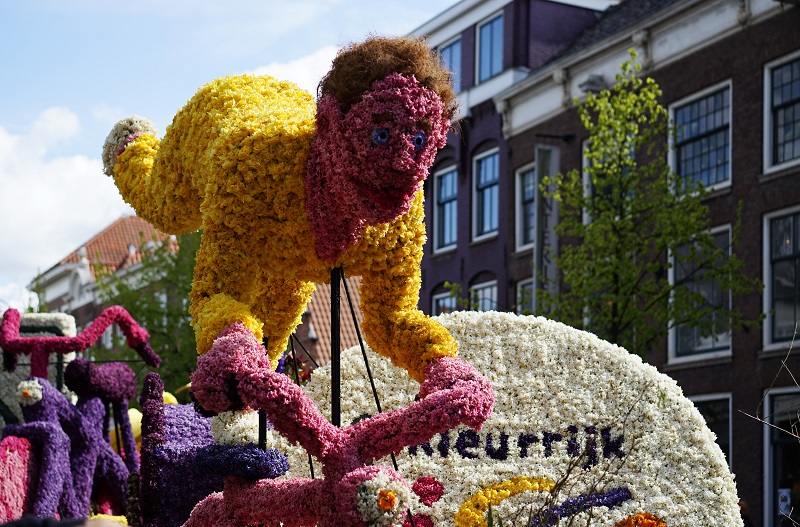
A bicycle in Holland is not only a vehicle, but also a part of national culture.
Bicycle lanes are everywhere in Holland, and this is not a literary exaggeration. From almost anywhere in the country you can get to any other, without dismounting from the bike. The tracks are highlighted in a different color, so it’s difficult to mix them up, and of course it’s not recommended to walk on them as a pedestrian. Yes, and it will not work, cycletrack is often quite lively.
If possible, bicycle lanes are physically separated from the sidewalk, although this is not always the case, and depends on the width of the street.
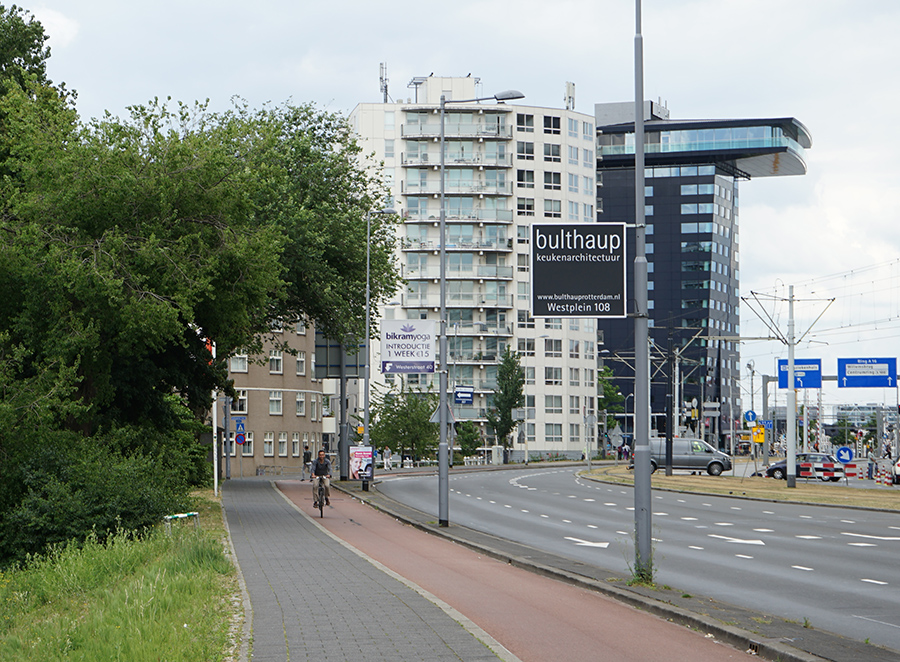
Of course, they are not always so empty; in the rush hour, it is rather like this:
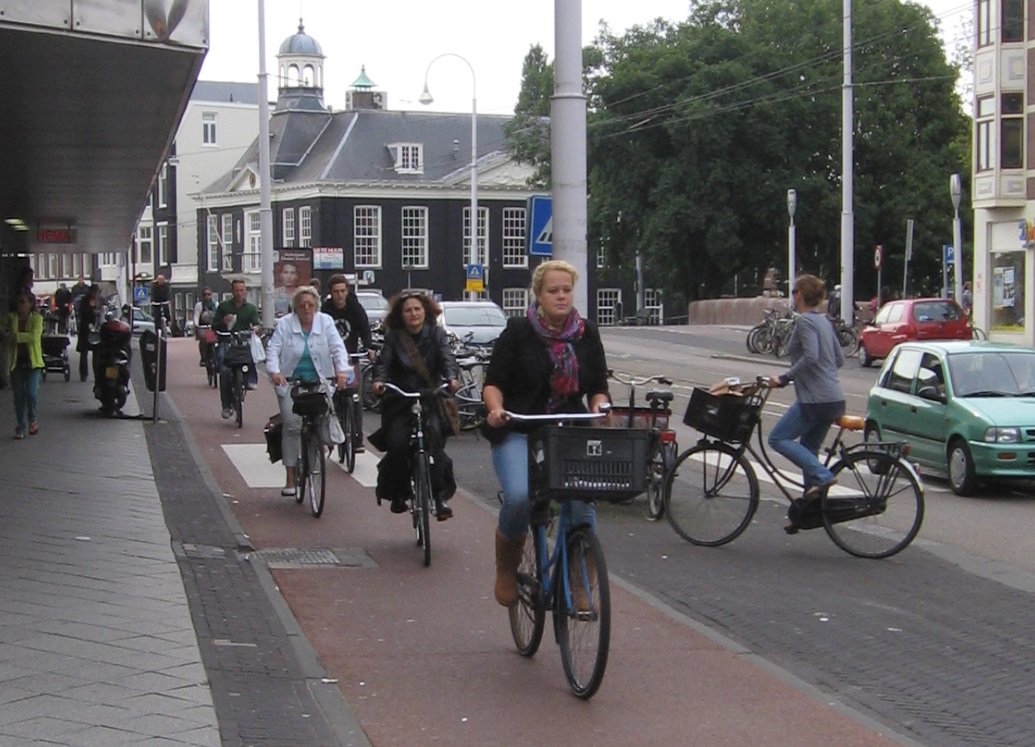
A source
By the way, they even sell special models of GPS receivers (for example, Garmin Edge) with stitched bicycle paths that pave the route for them.
Bicycle lanes themselves are in most cases separated not only from the sidewalk, but also from the roadway, and are generally quite safe - there is a clear marking, signs, individual traffic lights, each bike path is often duplicated on both sides of the road, so you don’t physically go . Therefore, the majority of the Dutch do not wear helmets, and the bicycle accident is practically an exception - of course you can fall down great, but it is difficult to seriously suffer.
By the way, why in Holland there are more bicycles than residents - the answer is simple. Many people use 2 big ones, they go from one house to the subway on one and leave it near the station, the second one goes from the final station to work. And some may have an old rusty large, which is not a pity to leave on the street, and another good home, for sports or longer weekend trips. By the way, with the average price of a tram or bus in 2Euro for the trip, the old used car is great for 100-200Euro, it will pay off for the season, even if you just throw it away (although the Dutch seem to have almost never been large, I don’t have such antique models in other places for a long time never seen).
Of course, for people to use bicycles, it is necessary that it is convenient. And the government is investing heavily in this. Almost every station or stop has bicycle parking - their size can range from a simple frame to a covered carport, or even underground parking for thousands of bicycles. And, often all this is free.
Parking spaces can vary in size, from:
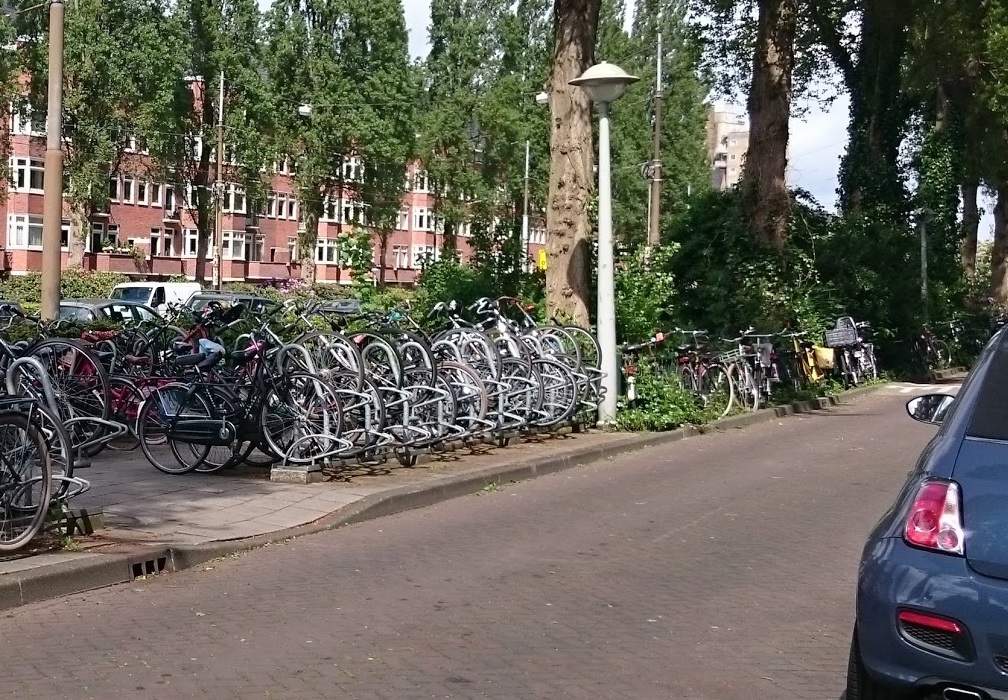
And to such:

A source
Huge underground bicycle parkings are being built, a couple of pictures to understand the scale of construction and the money invested:


(source - youtube video )
For example, such an underground parking lot was recently opened in the historical center of Amsterdam, 500m from Dam Square and Madame Tussauds:

A source
Of course, in almost every office center there is not only a cycle parking, but also a shower for employees.
But all the same, there are not enough parking lots at all, and most of the people have failed to go to them, so great is simply left on the street and tacked on to anything. In principle, any tree or pillar is also a good bicycle parking (if there is no rain, but this does not bother the owners - in this case, a package is simply put on the saddle).

Another important point is that you can take a subway or a train with a bicycle (during off-peak hours, and the number is limited to a few pieces per wagon). Cars where you can go with great, marked with a special sign:
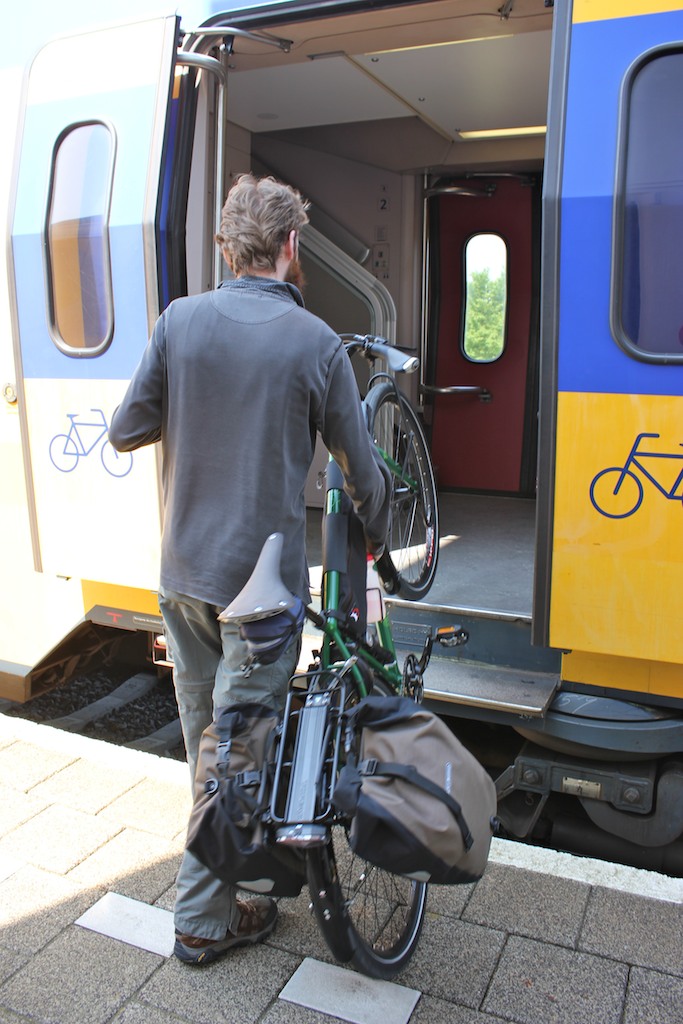
(Source: bikeshed.johnhoogstrate.nl/bicycle/trip/train_netherlands )
Great in Holland can be divided into several different species.
Antique trash
It is great 20-50 years ago, squeaky and rusty, which is not a pity to leave on the street and it is not a pity if soprut.

Bike for the transport of children
I do not know how it is called officially, but it is probably understandable from the picture. Enough expensive bike (the price can be up to 3000Euro for electric models), designed for transporting children.

On such a bike, mom or dad can bring the children to school or kindergarten, then go to work.
There are even special mega-stories in which a small group of kindergarten is placed at once:
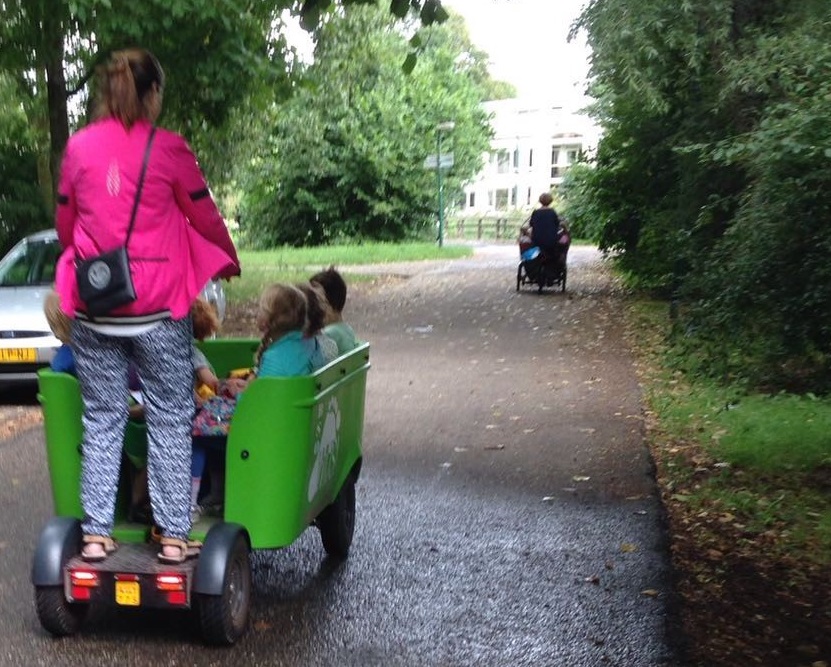
A source
Any exotic models also come across, for example, such a “recumbent” bike is called ligfiets, the German name liegerad is more popular in the world (liegen).

A source
Maybe he is better in terms of aerodynamics, only here his nefig is not visible on the road - no one in life can guess that something else can go at high speed down his legs.
Electric bicycles
Electric bikes have a constructive speed limit of up to 25 km / h, and are fully automatic - you should start to pedal, as the electric motor picks up. Power reserve up to 40km, which is quite convenient, although of course this bike is heavier and more expensive than usual.
More powerful models have a speed of up to 40 km / h and they seem to require the availability of a room and a helmet, but here I’m not surely in the know.
Folding bikes
This bike folds 2 times, and what is most convenient, it can be transported without restrictions to the subway or train.

Such a bike takes up really little space when folded:

A source
Scooter and other exotic
If I am not mistaken, for the time being they are outside the legal field and are not legally allowed. Motocables, however, are really exotic here, and are very, very rare (although there are prices in them). Scooters are also very rare.
As you can see, much can be done if people and the government want it. Of course, the climate also affects here (the average temperature in the winter in the Netherlands is + 3-5, and snow happens 1 week per year). But even in the Russian climate, if there is a good network of bike paths, I’m sure many would ride bicycles for at least 5-6 months a year. And this investment is also in the environment, in the fight against global warming, and so on and so forth. You can be indifferent to bicycles, but it must be admitted that every person who rode a bicycle is a reduction in CO2 emissions and cleaner air for others.
PS: This picture is not Holland at all, but Petersburg:
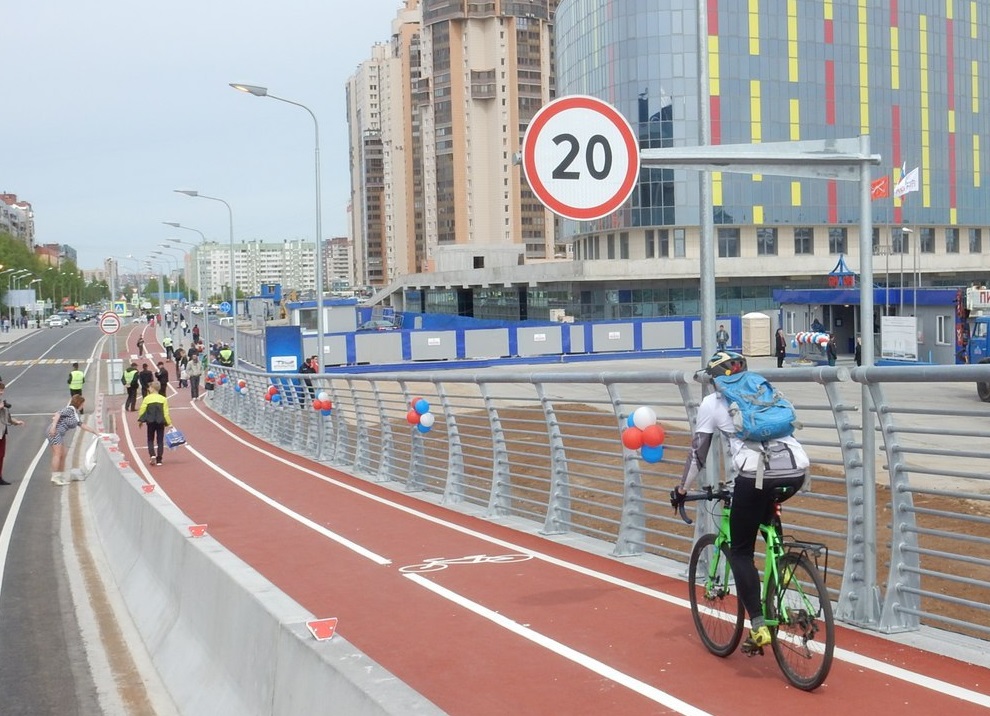
A source
The Dutch experience is adopted (it seems that experts were invited for consultations), and it pleases.
In recent years, in different cities of Russia began to pay more attention to the bicycle infrastructure. The process, of course, is slow and slightly “creaking” - cars are parked on bicycle paths, bicycle paths often do not stand up to winter with salt and are erased, and physically you can not place these bike paths everywhere. In general, there are problems, but it pleases that they are somehow trying to solve them.
Let's see how the bicycle infrastructure works in Holland - a country with a long bicycle history, where the number of bicycles is more than the number of inhabitants.
')

A bicycle in Holland is not only a vehicle, but also a part of national culture.
Cycle paths
Bicycle lanes are everywhere in Holland, and this is not a literary exaggeration. From almost anywhere in the country you can get to any other, without dismounting from the bike. The tracks are highlighted in a different color, so it’s difficult to mix them up, and of course it’s not recommended to walk on them as a pedestrian. Yes, and it will not work, cycletrack is often quite lively.
If possible, bicycle lanes are physically separated from the sidewalk, although this is not always the case, and depends on the width of the street.

Of course, they are not always so empty; in the rush hour, it is rather like this:

A source
By the way, they even sell special models of GPS receivers (for example, Garmin Edge) with stitched bicycle paths that pave the route for them.
Bicycle lanes themselves are in most cases separated not only from the sidewalk, but also from the roadway, and are generally quite safe - there is a clear marking, signs, individual traffic lights, each bike path is often duplicated on both sides of the road, so you don’t physically go . Therefore, the majority of the Dutch do not wear helmets, and the bicycle accident is practically an exception - of course you can fall down great, but it is difficult to seriously suffer.
By the way, why in Holland there are more bicycles than residents - the answer is simple. Many people use 2 big ones, they go from one house to the subway on one and leave it near the station, the second one goes from the final station to work. And some may have an old rusty large, which is not a pity to leave on the street, and another good home, for sports or longer weekend trips. By the way, with the average price of a tram or bus in 2Euro for the trip, the old used car is great for 100-200Euro, it will pay off for the season, even if you just throw it away (although the Dutch seem to have almost never been large, I don’t have such antique models in other places for a long time never seen).
Infrastructure
Of course, for people to use bicycles, it is necessary that it is convenient. And the government is investing heavily in this. Almost every station or stop has bicycle parking - their size can range from a simple frame to a covered carport, or even underground parking for thousands of bicycles. And, often all this is free.
Parking spaces can vary in size, from:

And to such:

A source
Huge underground bicycle parkings are being built, a couple of pictures to understand the scale of construction and the money invested:


(source - youtube video )
For example, such an underground parking lot was recently opened in the historical center of Amsterdam, 500m from Dam Square and Madame Tussauds:

A source
Of course, in almost every office center there is not only a cycle parking, but also a shower for employees.
But all the same, there are not enough parking lots at all, and most of the people have failed to go to them, so great is simply left on the street and tacked on to anything. In principle, any tree or pillar is also a good bicycle parking (if there is no rain, but this does not bother the owners - in this case, a package is simply put on the saddle).

Another important point is that you can take a subway or a train with a bicycle (during off-peak hours, and the number is limited to a few pieces per wagon). Cars where you can go with great, marked with a special sign:

(Source: bikeshed.johnhoogstrate.nl/bicycle/trip/train_netherlands )
Bicycles
Great in Holland can be divided into several different species.
Antique trash
It is great 20-50 years ago, squeaky and rusty, which is not a pity to leave on the street and it is not a pity if soprut.

Bike for the transport of children
I do not know how it is called officially, but it is probably understandable from the picture. Enough expensive bike (the price can be up to 3000Euro for electric models), designed for transporting children.

On such a bike, mom or dad can bring the children to school or kindergarten, then go to work.
There are even special mega-stories in which a small group of kindergarten is placed at once:

A source
Any exotic models also come across, for example, such a “recumbent” bike is called ligfiets, the German name liegerad is more popular in the world (liegen).

A source
Maybe he is better in terms of aerodynamics, only here his nefig is not visible on the road - no one in life can guess that something else can go at high speed down his legs.
Electric bicycles
Electric bikes have a constructive speed limit of up to 25 km / h, and are fully automatic - you should start to pedal, as the electric motor picks up. Power reserve up to 40km, which is quite convenient, although of course this bike is heavier and more expensive than usual.
More powerful models have a speed of up to 40 km / h and they seem to require the availability of a room and a helmet, but here I’m not surely in the know.
Folding bikes
This bike folds 2 times, and what is most convenient, it can be transported without restrictions to the subway or train.

Such a bike takes up really little space when folded:

A source
Scooter and other exotic
If I am not mistaken, for the time being they are outside the legal field and are not legally allowed. Motocables, however, are really exotic here, and are very, very rare (although there are prices in them). Scooters are also very rare.
findings
As you can see, much can be done if people and the government want it. Of course, the climate also affects here (the average temperature in the winter in the Netherlands is + 3-5, and snow happens 1 week per year). But even in the Russian climate, if there is a good network of bike paths, I’m sure many would ride bicycles for at least 5-6 months a year. And this investment is also in the environment, in the fight against global warming, and so on and so forth. You can be indifferent to bicycles, but it must be admitted that every person who rode a bicycle is a reduction in CO2 emissions and cleaner air for others.
PS: This picture is not Holland at all, but Petersburg:

A source
The Dutch experience is adopted (it seems that experts were invited for consultations), and it pleases.
Source: https://habr.com/ru/post/447632/
All Articles